Publications
WHO’s publications about nutrition range from short, user-friendly information products for a general audience to detailed reports and other technical works. All our publications can be downloaded free of charge.
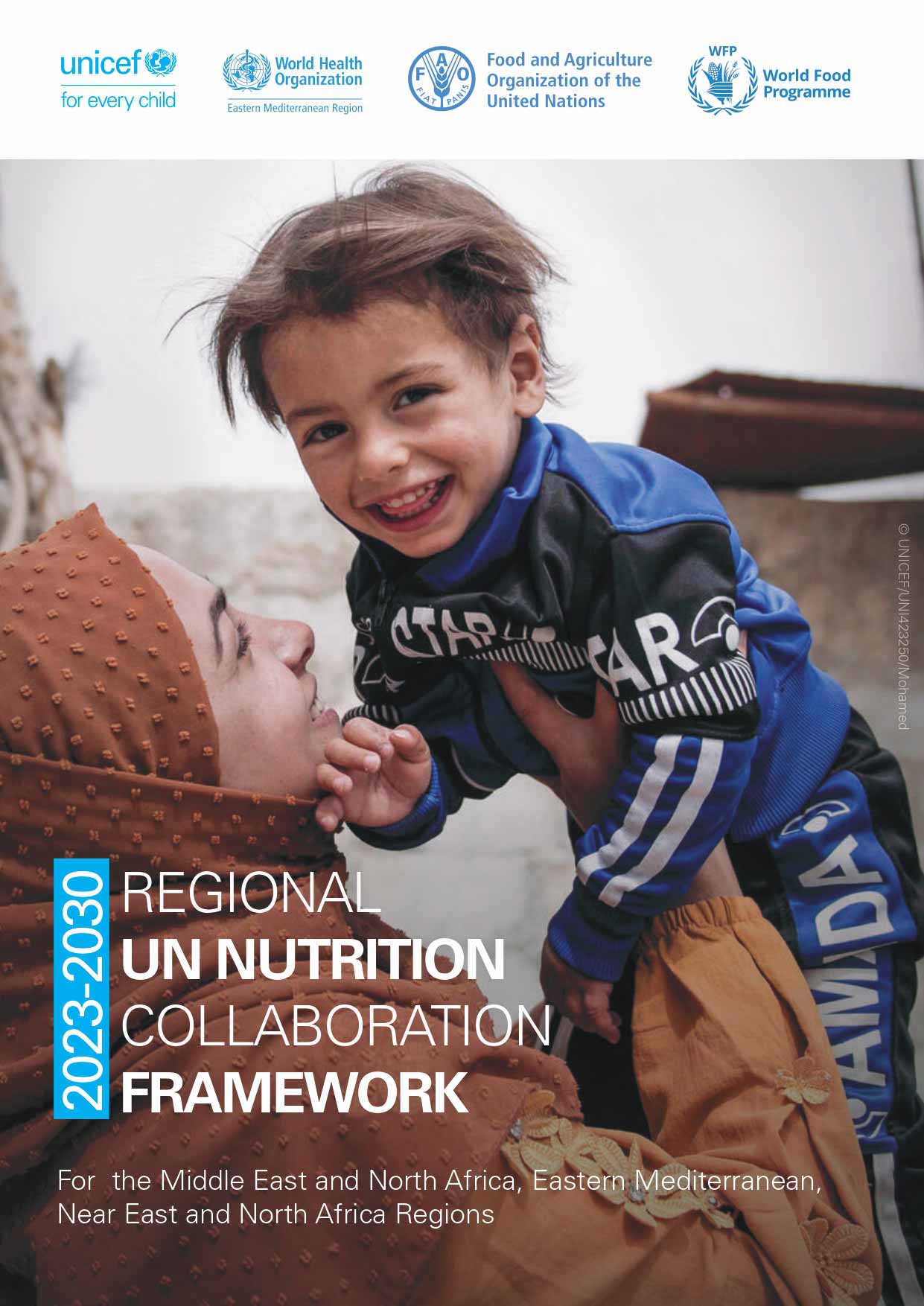
Regional UN Nutrition Collaboration Framework 2023-2030
Publication date: 2023
The Food and Agriculture Organization (FAO), the United Nations Children’s Fund (UNICEF), the World Health Organization (WHO), and the World Food Programme (WFP) have developed and agreed on a Regional Nutrition Collaboration Framework as a step towards strengthening the collaboration among the UN agencies and harmonizing their technical support on nutrition to the Middle East and North Africa (MENA), the Eastern Mediterranean (EM) and the Near East and North Africa (NENA) countries. This Framework aims to facilitate: identification of areas for strategic collaboration between the four UN agencies on nutrition throughout the life cycle; systematic technical collaboration and coordination at the regional level for accelerating action; joint and complementary actions on nutrition at the regional and country levels; harmonized joint support to countries on prioritizing and influencing action on nutrition; and joint advocacy, resource mobilization and knowledge management at the regional and country levels.
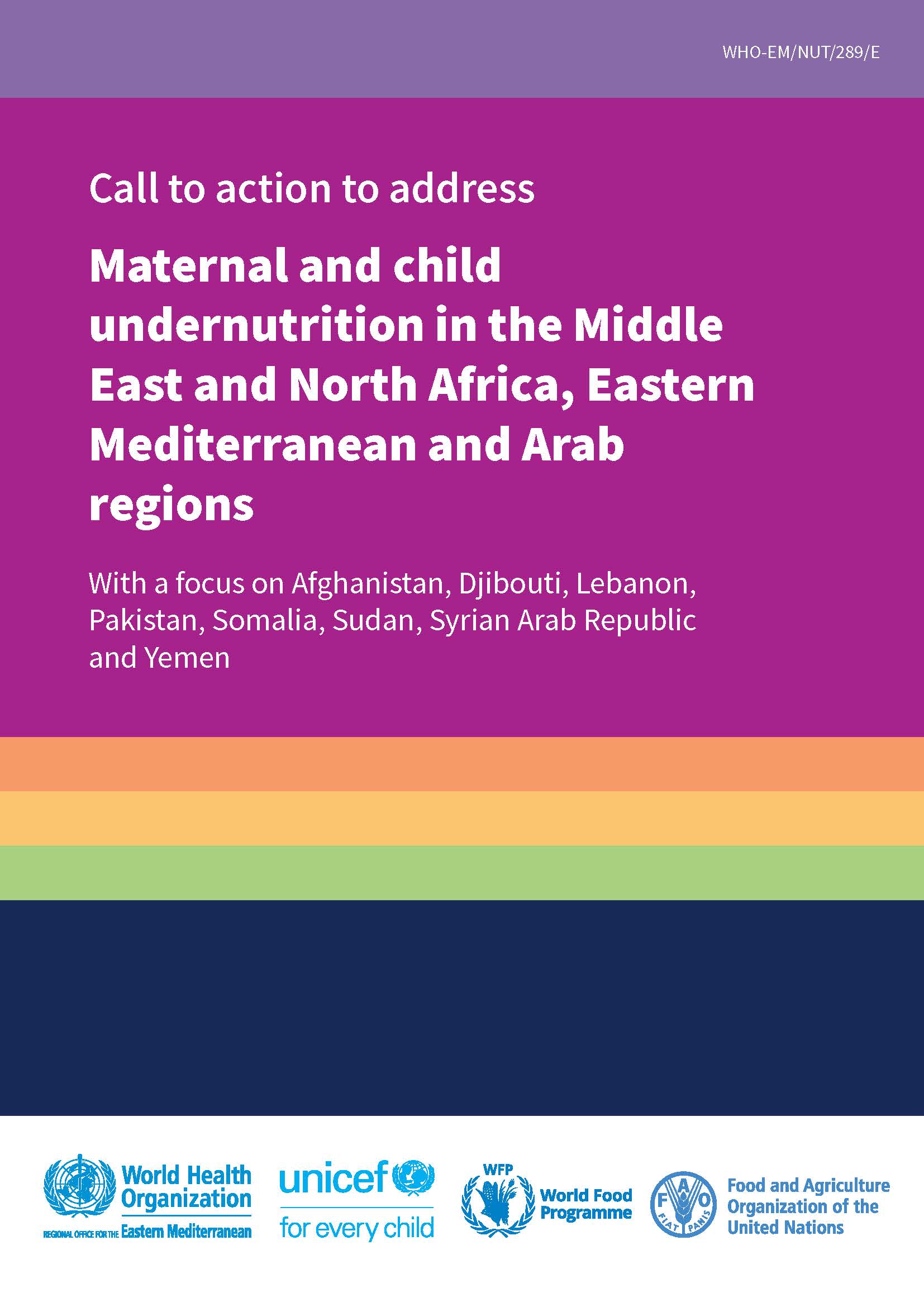
Call to action to address maternal and child undernutrition in the Middle East and North Africa, Eastern Mediterranean and Arab regions with a focus on Afghanistan, Djibouti, Lebanon, Pakistan, Somalia, Sudan, Syrian Arab Republic and Yemen
Publication date: 2022
Malnutrition in all its forms takes a heavy toll on the health, well-being and sustainable development of countries in the Middle East and North Africa, Eastern Mediterranean and Arab regions. Infants, young children, pregnant women and breastfeeding mothers, in particular, face significant risks to their nutritional status and well-being in contexts where access to essential health and nutrition services and affordable healthy diets is constrained. This call to action highlights some immediate priority areas to address the high undernutrition in the context of the current food security situation, the ongoing pandemic and the multiple crisis or post-crisis situations in the regions.
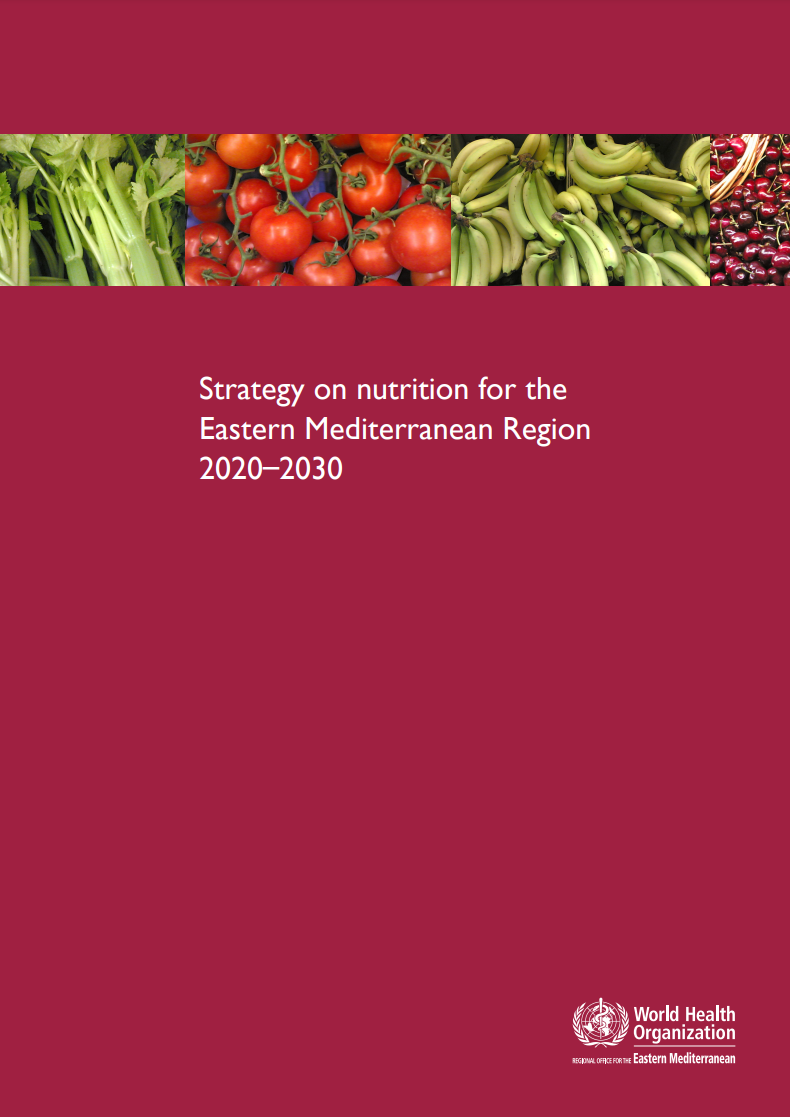
Strategy on nutrition for the Eastern Mediterranean Region 2020–2030
Publication date: 2019
The regional nutrition strategy aims to guide and strengthen country actions on nutrition to achieve food security, end all forms of malnutrition and improve nutrition throughout the life course by 2030. The document addresses the nutrition situation in the Region and outlines the objectives and recommended actions. It supports countries to operationalize a national nutrition strategy and plan of action to achieve global and regional nutrition targets. It also provides a framework for countries to improve nutrition and food security through the six key action areas of the United Nations Decade of Action on Nutrition.

Regional framework for action on obesity prevention 2019–2023
Publication date: 2019
Recognizing the rise in obesity and overweight prevalence in the Region during the last decades, the regional framework for action on obesity prevention translates a series of policy priorities into regional commitments. It provides countries with a set of evidence-based and cost-effective public health interventions with progress indicators to help prevent overweight and obesity in the Eastern Mediterranean Region. The covered intervention areas include fiscal measures, public procurement, food supply and trade, labelling, marketing, physical activity, mass media campaigns, breastfeeding, reformulation, health sector interventions, assessment and monitoring.

Healthy diet
Publication date: 2019
This document offers guidance on methods of maintaining a healthy diet for adults as well as infants and young children. It shows how adopting a healthy diet protects from malnutrition and the risks of noncommunicable diseases. There is also a dedicated section addressing policy-makers on effective actions for creating a healthy food environment for people and a final section listing the different mechanisms provided by WHO since 2004 to support countries in implementing their nutrition-related action plans.
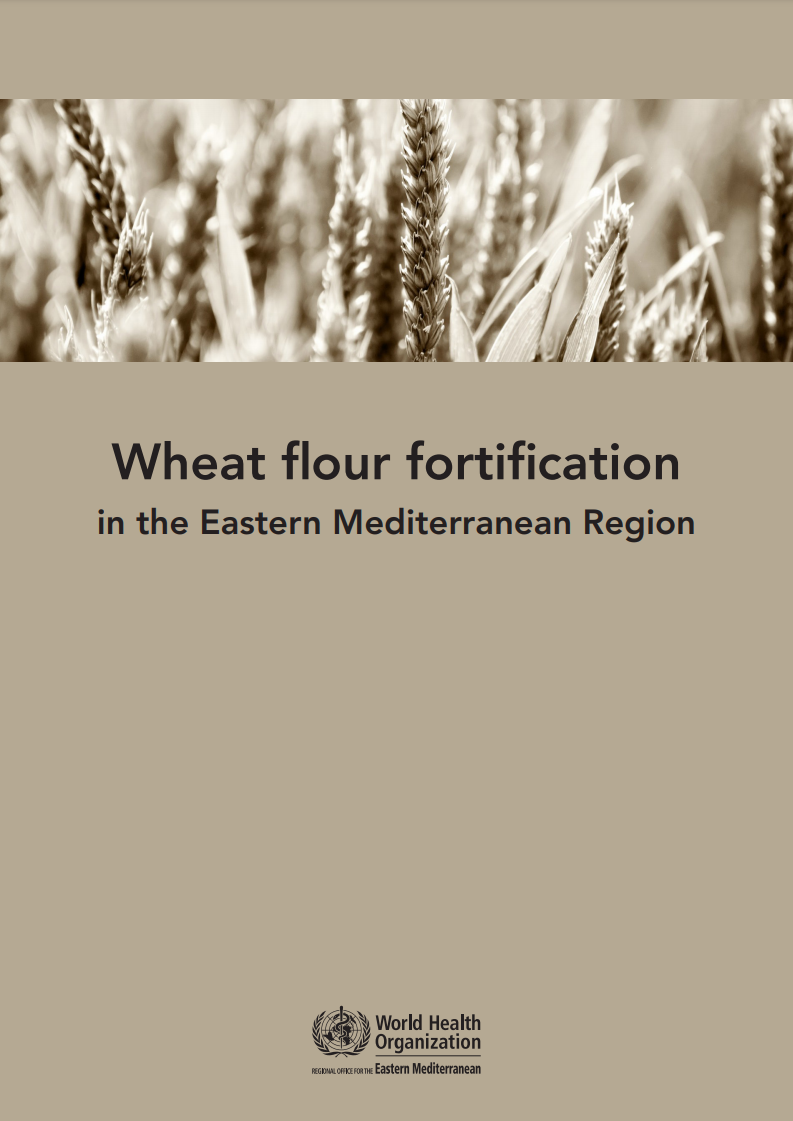
Wheat flour fortification in the Eastern Mediterranean Region
Publication date: 2019
Fortification of industrially-processed wheat flour is a simple, inexpensive and effective strategy for supplying vitamins and minerals to the diets of large segments of the Region’s population. This document summarizes information on the micronutrient deficiencies and the current state of wheat flour fortification in the Region, identifies common challenges and lessons learned from country experiences, outlines the latest guidance on best practices, and makes recommendations to advance appropriate wheat flour fortification in the Region.

Regional nutrition strategies to address the double burden in the Eastern Mediterranean
Publication date: 2018
The burden of disease associated with inadequate nutrition continues to grow in countries of the Eastern Mediterranean Region. Similar to many developing countries, the Region suffers from problems of both undernutrition and overweight, obesity and diet-related noncommunicable diseases. This article describes the nutrition situation in the Eastern Mediterranean Region through key indicators. It also presents WHO’s response to the double burden of malnutrition and discusses the key priorities, progress achieved and challenges faced in implementation. .
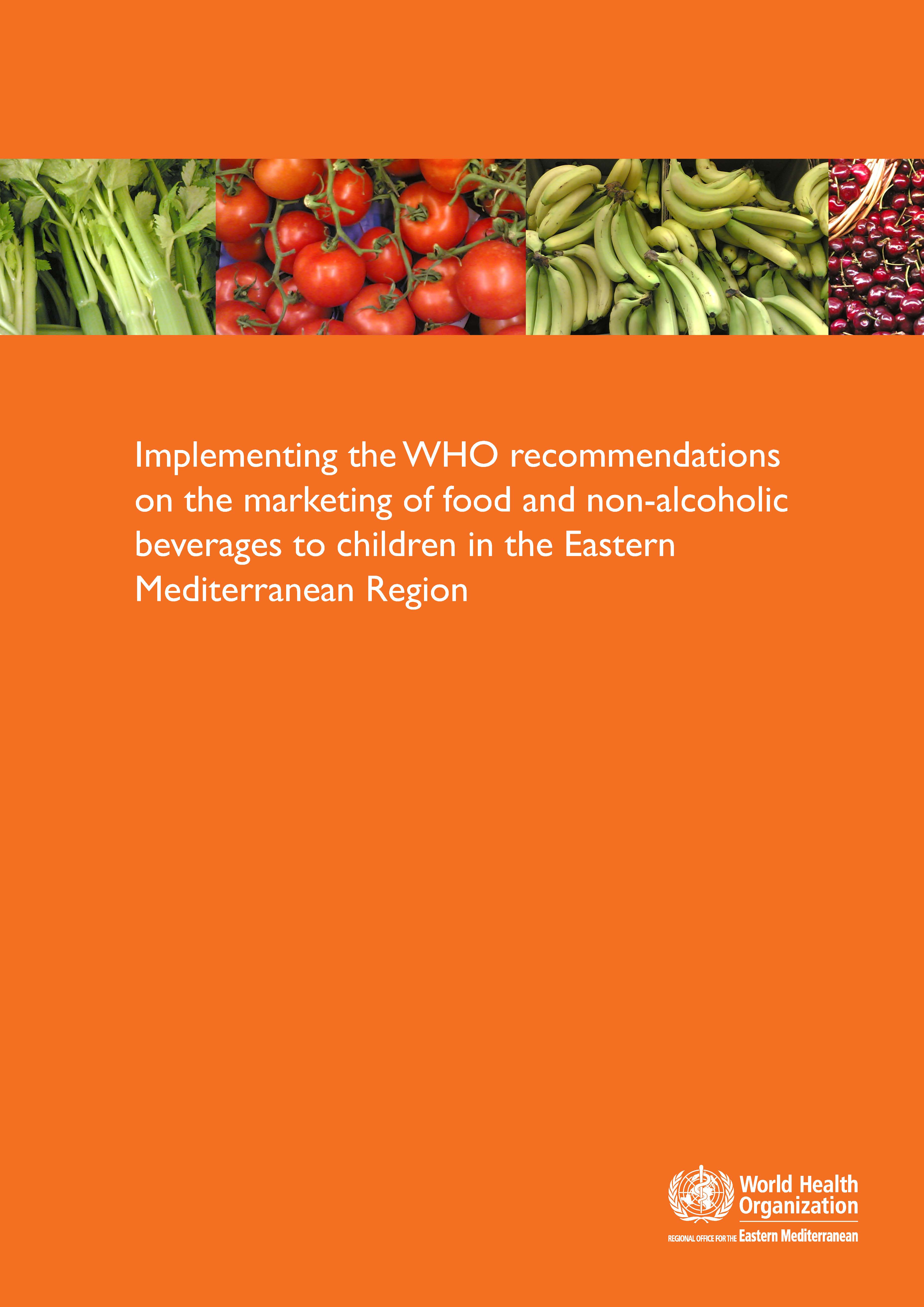
Implementing the WHO recommendations on the marketing of food and non-alcoholic beverages to children in the Eastern Mediterranean Region
Publication date: 2018
This report provides a situational analysis of the progress made in the Eastern Mediterranean Region in implementing the WHO set of recommendations, adopted by the World Health Assembly in 2010, which called on Member States to adopt policies restricting the marketing of unhealthy food to children. It offers guidance to Member States on how to urgently implement these recommendations as part of effective obesity prevention strategies. It also identifies the issues that countries need to consider when adopting policies intended to restrict the marketing of unhealthy food to children.
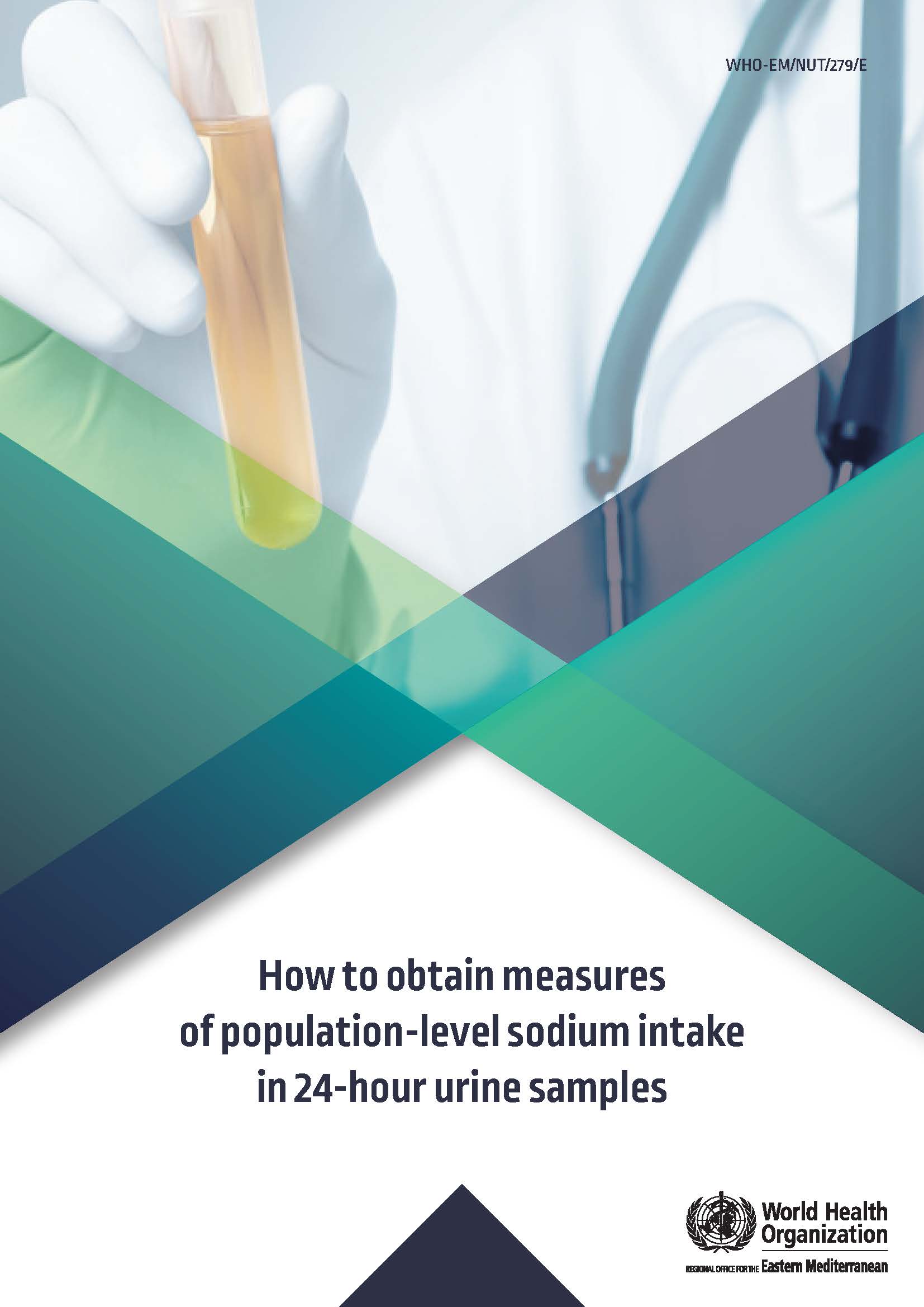
How to obtain measures of population-level sodium intake in 24-hour urine samples
Publication date: 2018
There is compelling evidence of the direct relationship between salt consumption and blood pressure. WHO is coordinating initiatives globally to reduce dietary salt intake at the population level. This document provides an essential salt intake measurement tool for countries in the Eastern Mediterranean Region that want to start, contribute to, and share information on dietary salt reduction initiatives. The protocol is primarily intended for principle investigator(s) of studies of salt/sodium, potassium and iodine intake. Parts of the document are also intended for field staff who are conducting the surveys.

Nutrient profile model for the marketing of food and non-alcoholic beverages to children in the WHO Eastern Mediterranean Region
Publication date: 2017
This regional nutrient profile model was developed based on the model from the WHO Regional Office for Europe, adapting it to the context of the Eastern Mediterranean Region. The model is designed for use by governments to regulate and restrict food marketing to children. It provides a categorization for food items and proposes clear requirements for the nutritional content of food items whose marketing to children is permitted. In addition to the model itself, the document includes a rationale and background for the model and instructions for use.

Proposed policy priorities for preventing obesity and diabetes in the Eastern Mediterranean Region
Publication date: 2017
The alarming and escalating burden of overweight, obesity and diabetes in the Eastern Mediterranean Region is closely linked to changing dietary patterns. Obesity and the most common type of diabetes are largely preventable and urgent action is needed to reduce exposure to their causal factors, such as unhealthy diet and physical inactivity. This document considers the recommendations of several recent initiatives on the prevention of obesity and diabetes and identifies priorities for an approach to reduce exposure to unhealthy dietary risk factors. It presents an initial proposal for 10 priority areas for action, which cover 37 strategic interventions to help prevent overweight, obesity and diabetes in the whole population, including children, adolescents and adults.

Ambition and action in nutrition 2016–2025
Publication date: 2017
Ambition and action in nutrition 2016–2025 is WHO’s first inclusive, multi-level, fit-for-purpose global nutrition strategy. This document describes the context of global nutrition momentum including the globally agreed sets of nutrition targets, defines the vision and mission for nutrition, and identifies the priorities for WHO’s work in nutrition. It provides the clarity and framework for aligning nutrition work within WHO and with partners. The strategy steers WHO’s actions in nutrition in the spirit of the United Nations 2030 Agenda for Sustainable Development and Decade of Action on Nutrition 2016–2025.
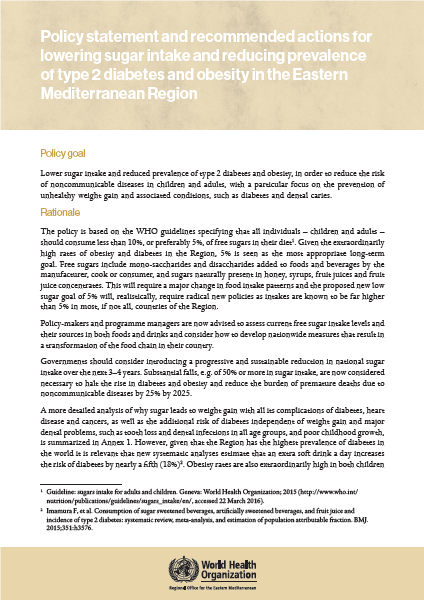
Policy statement and recommended actions for lowering sugar intake and reducing prevalence of type 2 diabetes and obesity in the Eastern Mediterranean Region
Publication date: 2016
This policy statement and proposed action plan is part of the WHO Regional Office for the Eastern Mediterranean’s effort to reach the global targets of halting the rise in diabetes and obesity and reduce the burden of premature deaths due to noncommunicable diseases by 25% by 2025. Through a four-phased approach, this policy statement provides the steps that countries should follow to reduce sugar intake, which consequently leads to maintaining a normal body weight, avoiding type 2 diabetes and also preventing dental caries in children and adults.
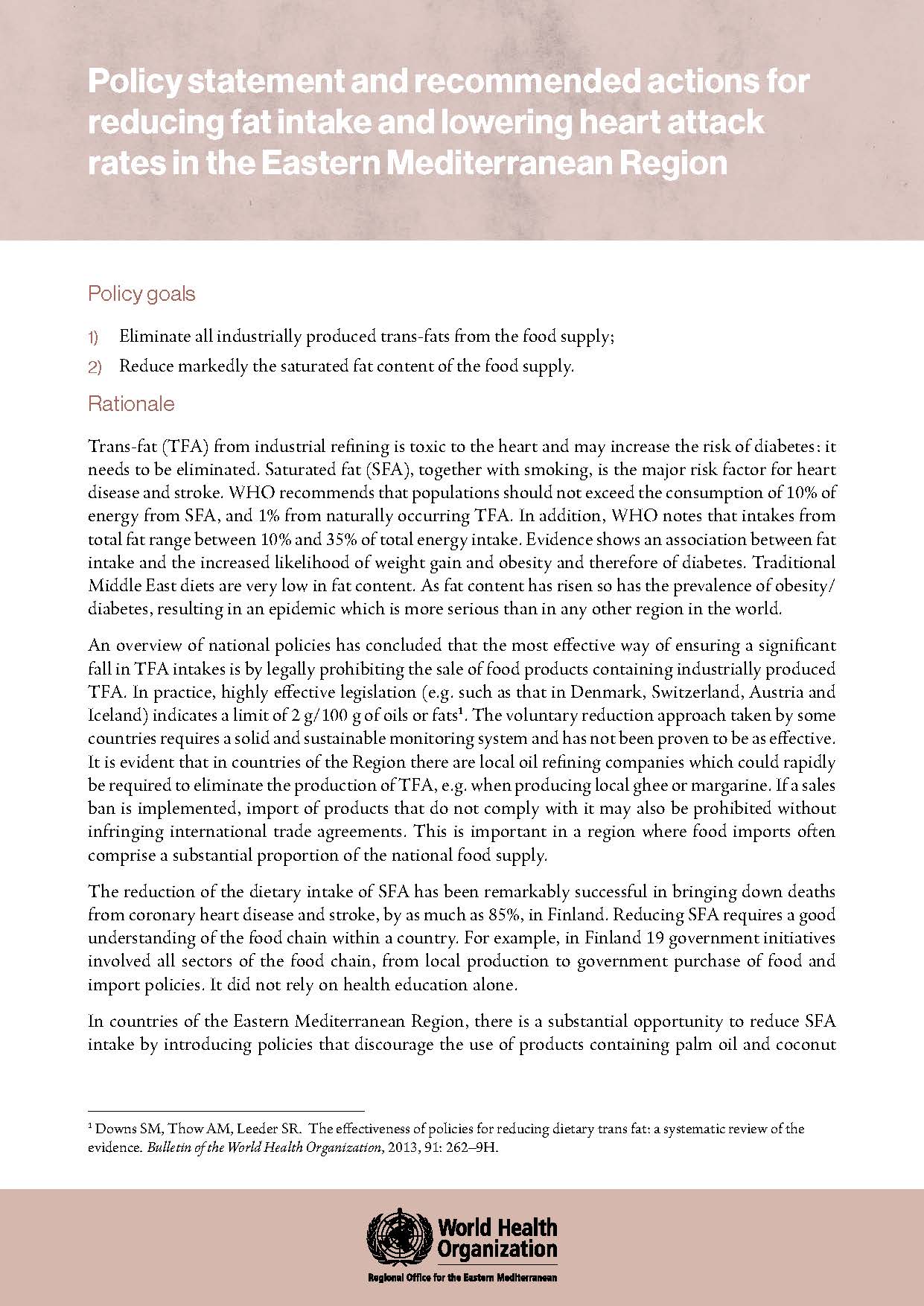
Policy statement and recommended actions for reducing fat intake and lowering heart attack rates in the Eastern Mediterranean Region
Publication date: 2014
This policy statement was published in 2014 with the goal of identifying the priority actions for Member States to eliminate all industrially produced trans-fats from the food supply as well as to reduce markedly the saturated fat content of the food supply. The suggested actions are divided into three phases which span over a period of two-years from 2014 to 2015.
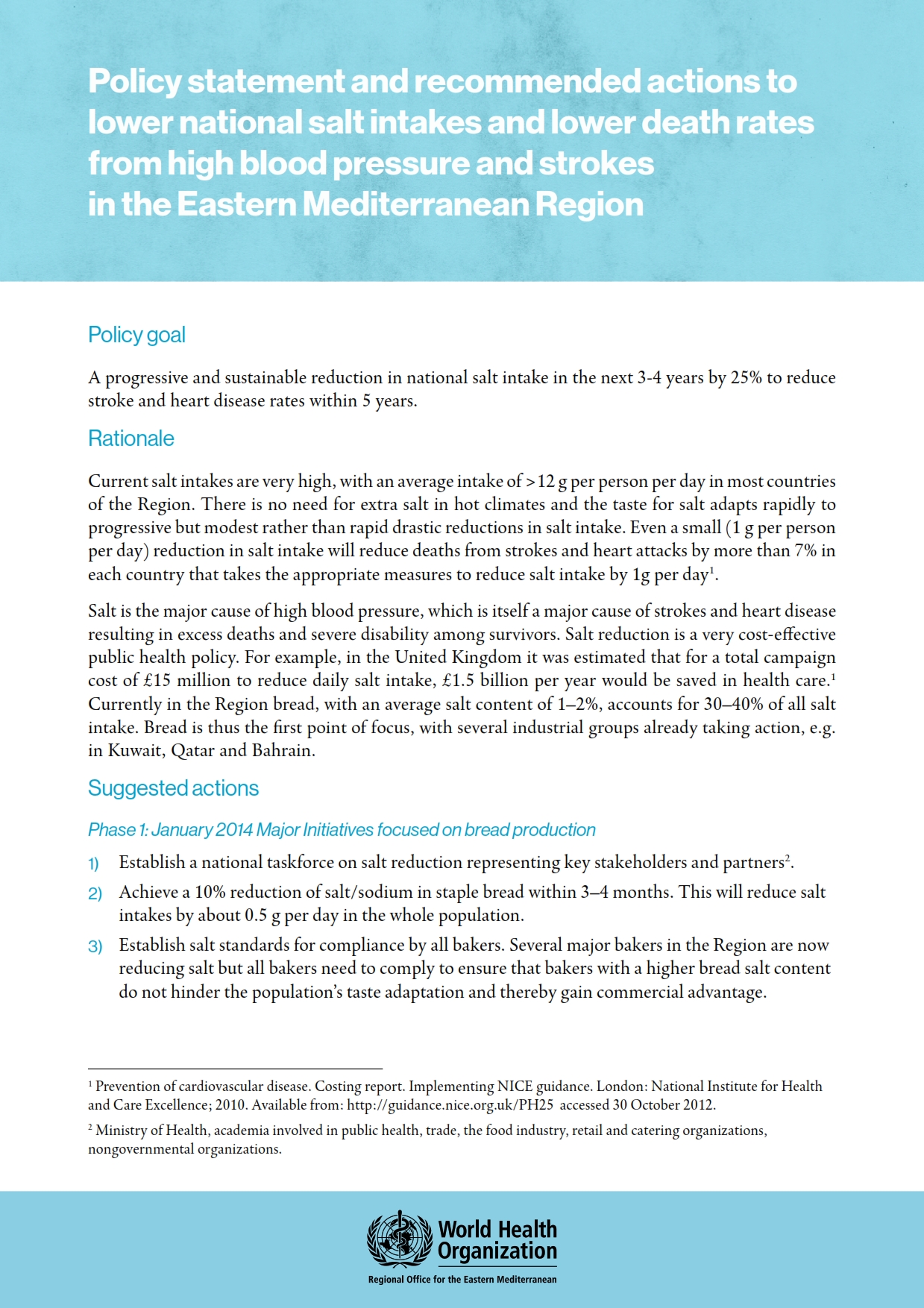
Policy statement and recommended actions to lower national salt intake and death rates from high blood pressure and stroke in the Eastern Mediterranean Region
Publication date: 2014
This policy statement was published in 2014, aiming to achieve progressive and sustainable reduction in national salt intake in the following 3–4 years by 25% to reduce stroke and heart disease rates within 5 years. It addresses the salt intake in countries of the Eastern Mediterranean Region and suggests several country-level actions for achieving salt reduction in three phases.
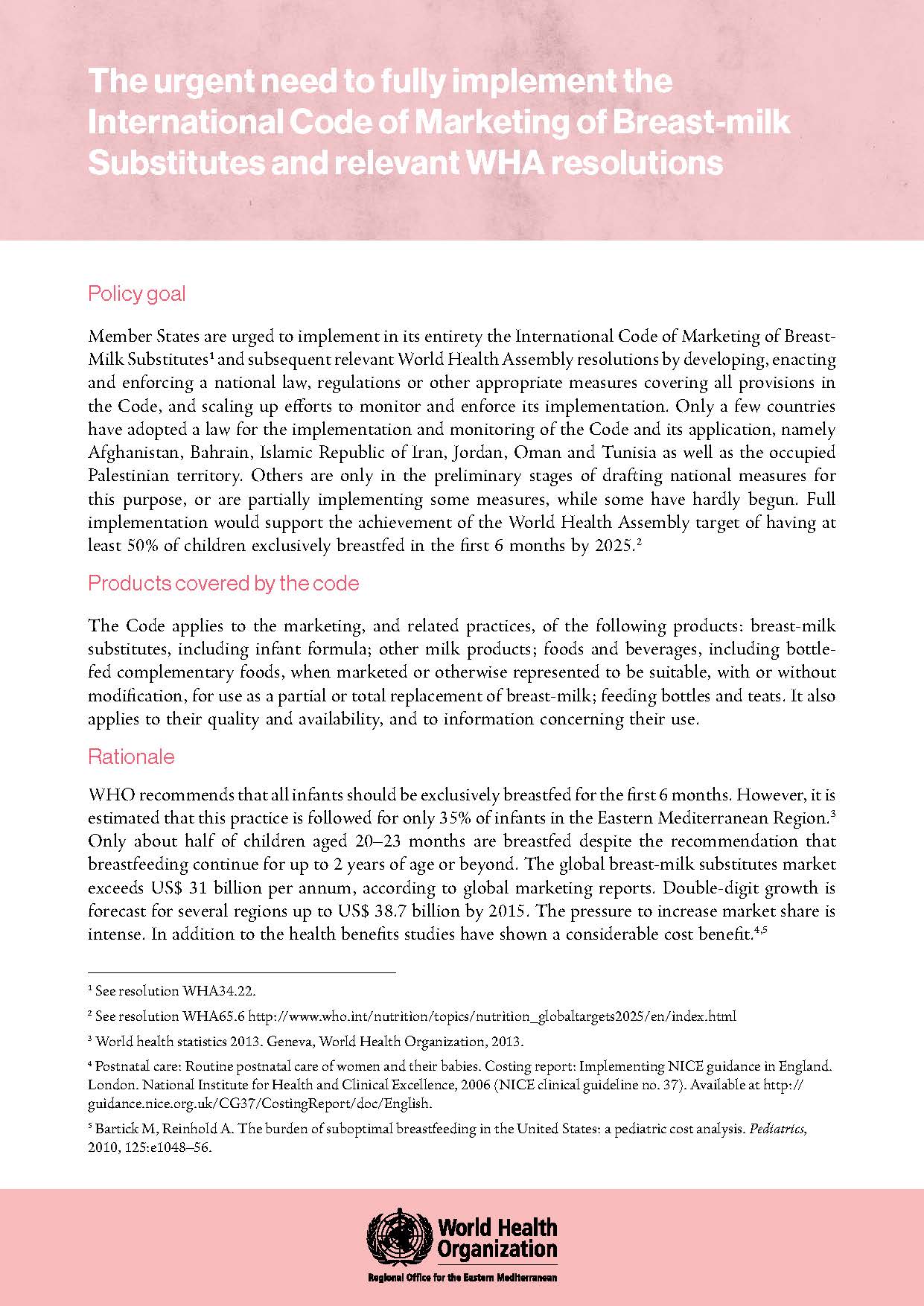
The urgent need to fully implement the International Code of Marketing of Breast-milk Substitutes and relevant WHA resolutions
Publication date: 2014
This policy statement was published in 2014 aiming to urge Member States to implement in its entirety the International Code of Marketing of Breast Milk Substitutes and subsequent relevant World Health Assembly resolutions by developing, enacting and enforcing a national law, regulations or other appropriate measures covering all provisions in the Code, and scaling up efforts to monitor and enforce its implementation.

Food and nutrition surveillance systems: a manual for policy-makers and programme managers
Publication date: 2014
This manual is designed to be a user reference manual for policy-makers and programme managers for the development of a food and nutrition surveillance system, with the focus on application. It presents a model for developing a surveillance system and provides a general overview of the basic principles, as well as the essential steps and issues involved in the different activities to be undertaken. The content is organized in six modules, considering the concept and basic principles, background of malnutrition, indicators for food and nutrition surveillance systems, measuring of malnutrition, supervision, monitoring and evaluation, and data management and processing.

Food and nutrition surveillance systems: a guide for trainers
Publication date: 2014
This guide is a practical and comprehensive tool for facilitators to conduct training in food and nutrition surveillance systems. It contains a clear protocol for the training including training topics, schedule, exercises and supporting materials. The expected outcome of the training is participants’ increased capacity to plan and prepare for surveillance, conduct data collection, analyse the data collected and report and disseminate the results. It is intended for use in conjunction with Food and nutrition surveillance systems: a manual for policy-makers and programme managers.
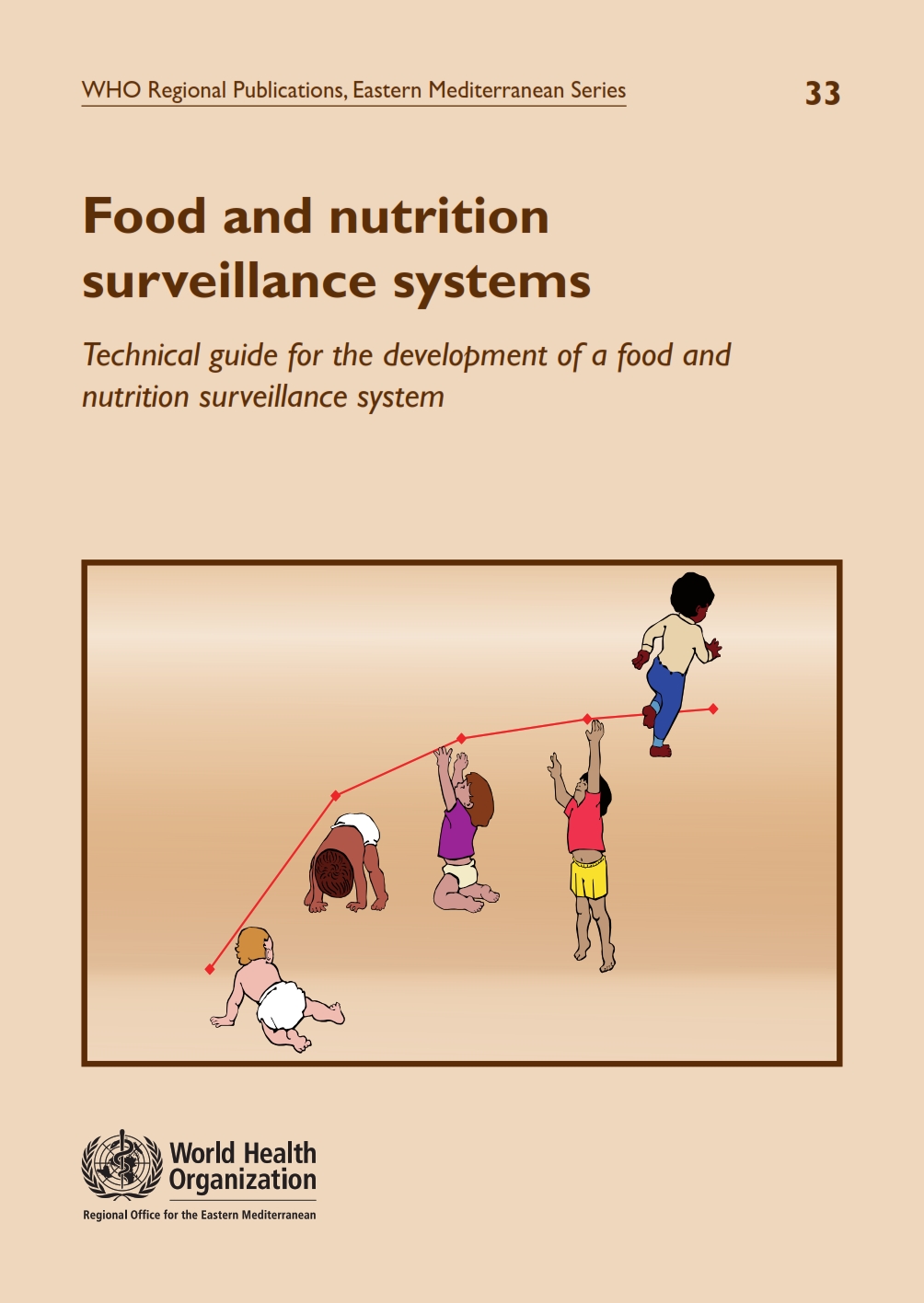
Food and nutrition surveillance systems: technical guide for the development of a food and nutrition surveillance system
Publication date: 2013
As food and nutrition policies and programmes require a strong evidence base, there is a need for a sustained food and nutrition surveillance systems in countries. The main objective of this document is to provide the technical background for the development of a national food and nutrition surveillance system. The document explains thoroughly the concept of food and nutrition system and describes the different types of indicators that can be used to measure the nutritional determinants or consequences of interventions and policies.
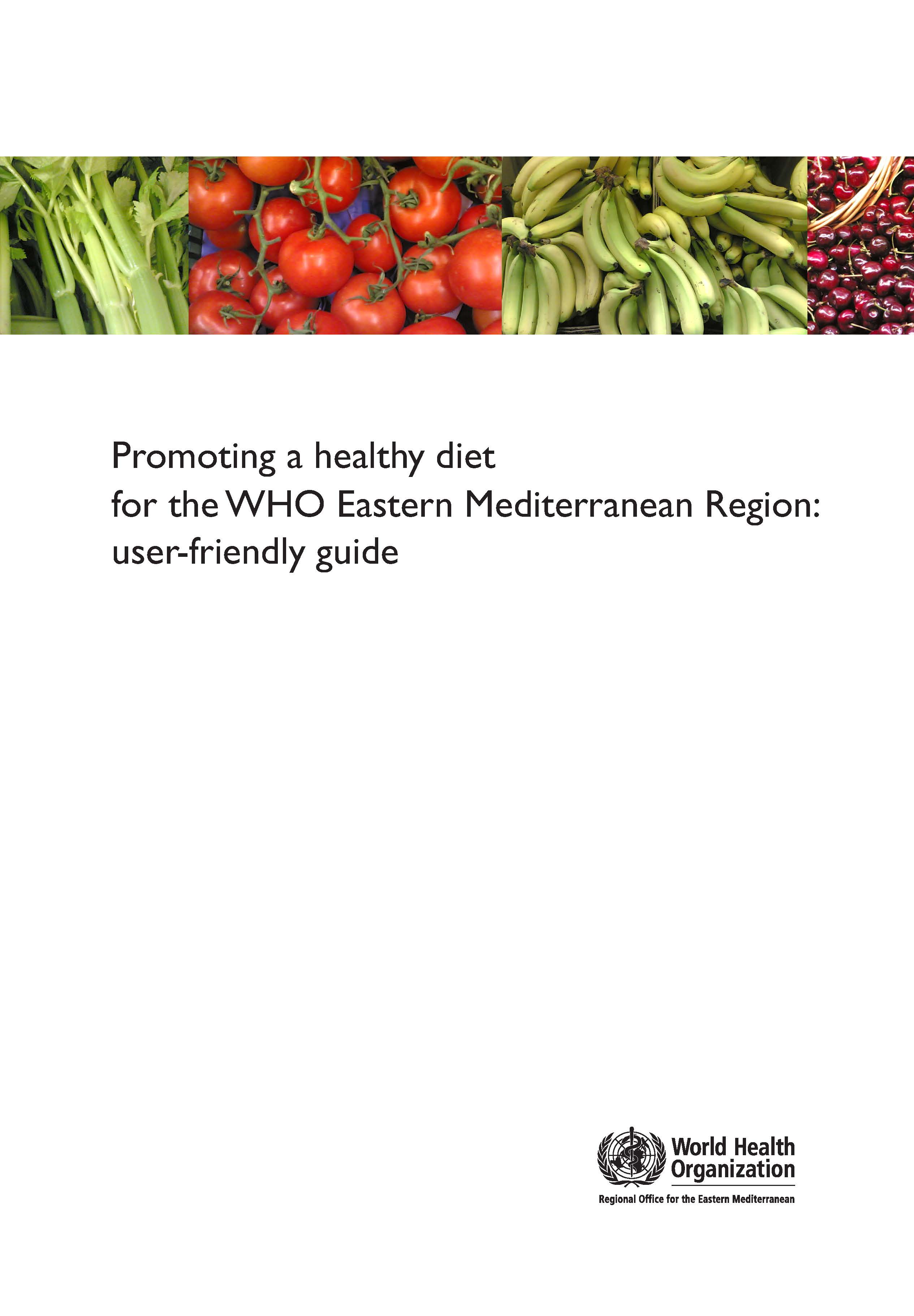
Promoting a healthy diet for the WHO Eastern Mediterranean Region: user-friendly guide
Publication date: 2012
This user-friendly guide provides dietary advice to promote health and reduce the risk of major chronic diseases through diet and physical activity. It presents a set of dietary recommendations that are compatible with the different cultures and eating patterns of consumers in the Region. It represents an essential tool in supporting national and regional strategies to improve nutrition outcomes and health in the Region. It is primarily intended for use by policy-makers, health care providers, nutritionists, nutrition educators and anyone involved in food distribution and food service. It can also be used by schools, homes, cafeterias and businesses to improve the food choices for a range of consumers.
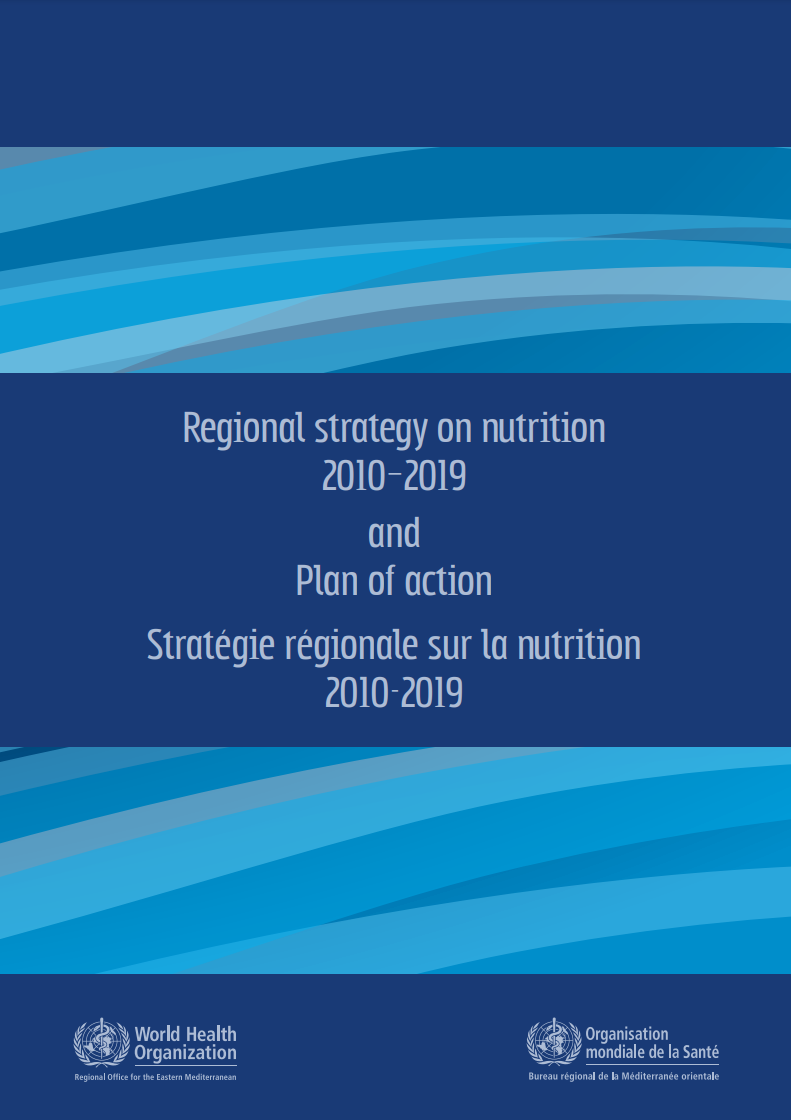
Regional strategy on nutrition 2010–2019 and Plan of action
Publication date: 2011
This is the previous strategy and plan of action on nutrition for WHO’s Eastern Mediterranean Region, covering the period from 2010 to 2019. It outlined the approaches to address the major health and nutrition problems in the Region. The strategic approaches targeted undernutrition, micronutrient deficiencies, prevention and control of obesity and noncommunicable diseases. The strategy emphasized support for the most vulnerable groups and alleviation of poverty and hunger, the root causes of malnutrition. The strategy was developed in the context of the Millennium Development Goals. The Arabic and French versions are included in the same document.

Framework for the implementation of the Global Strategy on Diet, Physical Activity and Health in the Eastern Mediterranean Region: working document
Publication date: 2010
Many of the major risk factors for noncommunicable diseases (NCDs) are closely related to physical inactivity and unhealthy diet. To address the growing burden of NCDs, in 2002 WHO began developing the Global Strategy on Diet, Physical Activity and Health, which was adopted by the World Health Assembly in 2004. The purpose of this framework is to assist countries in implementing the Global Strategy on Diet, Physical Activity and Health, with the goal of reducing morbidity and mortality due to NCDs. It also proposes strategic actions that will be integrated within the regional nutrition action plan.
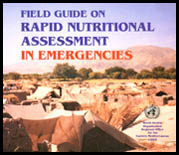
Field guide on rapid nutritional assessment in emergencies
Publication date: 1995
The WHO EMRO Consultation on Rapid Nutritional Emergencies was called to develop a set of guidelines for the rapid assessment of nutritional status needed in emergencies, with clear instructions for use in the field. Experts and WHO discussed and agreed on major problem areas in nutritional assessment such as choice of indicators, sampling requirements, methodology and analysis, use and users of the information. This field guide will guide the user through the entire process of designing, planning, implementing, and reporting reliable nutritional assessment. It will also be a useful companion for all those faced with disasters in the Eastern Mediterranean Region and outside.


